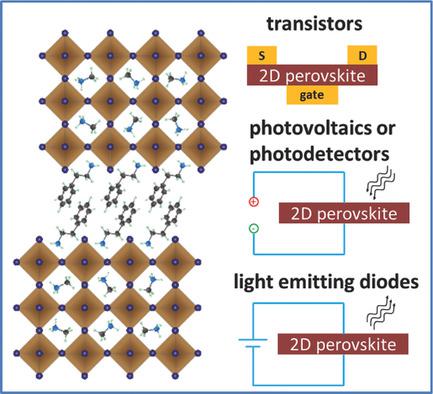当前位置:
X-MOL 学术
›
Adv. Mater.
›
论文详情
Our official English website, www.x-mol.net, welcomes your
feedback! (Note: you will need to create a separate account there.)
Two‐Dimensional Organic–Inorganic Hybrid Perovskites: A New Platform for Optoelectronic Applications
Advanced Materials ( IF 27.4 ) Pub Date : 2018-09-10 , DOI: 10.1002/adma.201802041 Jun Hu 1 , Liang Yan 1 , Wei You 1, 2
Advanced Materials ( IF 27.4 ) Pub Date : 2018-09-10 , DOI: 10.1002/adma.201802041 Jun Hu 1 , Liang Yan 1 , Wei You 1, 2
Affiliation

|
2D perovskites are recently attracting a significant amount of attention, mainly due to their improved stability compared with their 3D counterpart, e.g., the archetypical MAPbI3. Interestingly, the first studies on 2D perovskites can be dated back to the 1980s. The most popular 2D perovskites have a general formula of (RNH3)2MAn−1MnX3n+1, where n represents the number of metal halide octahedrons between the insulating organic cation layers. The optoelectronic properties of 2D perovskites, e.g., band gap, are highly dependent on the thickness of the inorganic layers (i.e., the value of n). Herein, 2D perovskites are arbitrarily divided into three classes, strict 2D (n = 1), quasi‐2D (n = 2–5), and quasi‐3D (n > 5), and research progress is summarized following this classification. The majority of existing 2D perovskites only employ very simple organic cations (e.g., butyl ammonium or phenylethyl ammonium), which merely function as the supporting layer/insulating barrier to achieve the 2D structure. Thus, a particularly important research question is: can functional organic cations be designed for these 2D perovskites, where these functional organic cations would play an important role in dictating the optoelectronic properties of these organic–inorganic hybrid materials, leading to unique device performance or applications?
中文翻译:

二维有机-无机杂化钙钛矿:光电应用的新平台
2D钙钛矿最近引起了极大的关注,这主要是由于与3D钙钛矿(例如原型MAPbI 3)相比,它们具有更高的稳定性。有趣的是,有关2D钙钛矿的最早研究可以追溯到1980年代。最受欢迎的2D钙钛矿的通式为(RNH 3)2 MA n -1 M n X 3 n +1,其中n表示绝缘有机阳离子层之间的金属卤化物八面体的数目。二维钙钛矿的光电性能(例如,带隙)高度取决于无机层的厚度(即,n的值)。在这里,二维钙钛矿被任意地分为三类,严格的2D(n = 1),准2D(n = 2-5)和准3D(n > 5),并且根据这种分类总结了研究进展。现有的大多数2D钙钛矿仅使用非常简单的有机阳离子(例如,丁基铵或苯乙基铵),它们仅用作实现2D结构的支撑层/绝缘层。因此,一个特别重要的研究问题是:能否为这些2D钙钛矿设计功能性有机阳离子,其中这些功能性有机阳离子将在决定这些有机-无机杂化材料的光电性能中发挥重要作用,从而导致独特的器件性能或应用?
更新日期:2018-09-10
中文翻译:

二维有机-无机杂化钙钛矿:光电应用的新平台
2D钙钛矿最近引起了极大的关注,这主要是由于与3D钙钛矿(例如原型MAPbI 3)相比,它们具有更高的稳定性。有趣的是,有关2D钙钛矿的最早研究可以追溯到1980年代。最受欢迎的2D钙钛矿的通式为(RNH 3)2 MA n -1 M n X 3 n +1,其中n表示绝缘有机阳离子层之间的金属卤化物八面体的数目。二维钙钛矿的光电性能(例如,带隙)高度取决于无机层的厚度(即,n的值)。在这里,二维钙钛矿被任意地分为三类,严格的2D(n = 1),准2D(n = 2-5)和准3D(n > 5),并且根据这种分类总结了研究进展。现有的大多数2D钙钛矿仅使用非常简单的有机阳离子(例如,丁基铵或苯乙基铵),它们仅用作实现2D结构的支撑层/绝缘层。因此,一个特别重要的研究问题是:能否为这些2D钙钛矿设计功能性有机阳离子,其中这些功能性有机阳离子将在决定这些有机-无机杂化材料的光电性能中发挥重要作用,从而导致独特的器件性能或应用?











































 京公网安备 11010802027423号
京公网安备 11010802027423号